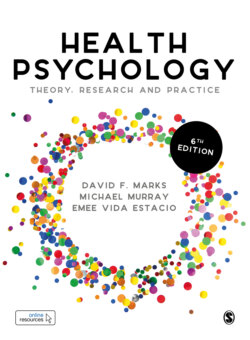Читать книгу Health Psychology - Michael Murray - Страница 34
На сайте Литреса книга снята с продажи.
The circadian clock
ОглавлениеThe ES regulates the circadian rhythm and sleep/waking cycle with a variety of hormone releases. Melatonin is produced in the pineal gland, under the control of the central circadian pacemaker in the suprachiasmatic nucleus (SCN) region of the hypothalamus (Gamble et al., 2014). Melatonin relays information about the light–dark cycle in response to day-length changes, triggering endocrine changes. Melatonin production is low in the presence of light and increases during the night when it induces and supports sleep. Melatonin supplementation is used for the treatment of winter depression and sleep disorders, and as an adjuvant therapy for epilepsy.
The hypothalamo-pituitary-adrenal (HPA) axis produces corticotropin releasing hormone (CRH) from the hypothalamus and conveys it to the anterior pituitary gland. There, CRH triggers release of adrenocorticotropic hormone (ACTH) into the general circulation whereupon ACTH binds to receptors in the adrenal gland and stimulates cortisol release. Cortisol levels exhibit a robust ultraradian rhythm normally peaking during the morning (0700–0800), preparing the body for the energetic demands of waking.
Growth hormone (GH) is produced in the anterior pituitary in response to the integrated stimulatory and inhibitory effects of GH releasing hormone (GHRH) and somatostatin (SMS), respectively, from the hypothalamus. GH has powerful metabolic effects in opposition to insulin (e.g., decreasing glucose utilization). Circulating GH levels exhibit both circadian and ultradian variation, as well as sexual dimorphism. GH is secreted throughout the day with an increased secretion during sleep.
Adiponectin exhibits a time-of-day-dependent rhythm, peaking between 1200 and 1400 and is best known as an insulin sensitizer, whose circulating levels vary inversely with body mass index (BMI). Hypoadiponectinemia is associated with metabolic syndrome, but conversely, elevated levels are seen in chronic heart failure and chronic renal failure. Insulin is secreted by beta cells of pancreatic islets in response to increased levels of circulating nutrients, particularly glucose. Insulin stimulates glucose utilization and protein synthesis by the liver, skeletal muscle and fat. It displays a diurnal rhythm which peaks at around 1700 hours, suggestive of nutrient storage during the awake/fed state and mobilization during the fast period of sleep.
The EC responds in a complex manner during sleep (Van Cauter and Tasali, 2011). The secretion of some hormones increases during sleep (e.g., growth hormone, prolactin and luteinizing hormone), while the secretion of other hormones is inhibited (e.g., thyroid stimulating hormone and cortisol). Some hormones are directly linked to a particular sleep stage. Growth hormone is typically secreted in the first few hours after the onset of sleep and generally occurs during slow-wave sleep. Cortisol is tied to the circadian rhythm and peaks in late afternoon, regardless of the person’s sleep status or the darkness/light cycle. Melatonin is released in the dark and is suppressed by light (Buxon et al., 2002). Thyroid hormone secretion occurs in the late evening (Institute of Medicine, 2006). Endocrine dysfunction has been linked to sleep disturbances such as insomnia (Institute of Medicine, 2006). It has been suggested that over-activity of the HPA axis in response to stress affects sleep and subsequently increases the secretion of cortisol and norepinephrine (Buckley and Schatzberg, 2005).
Figure 2.10 Circadian clock control of endocrine factors
Time of day at which circulating levels of key endocrine factors peak in humans. Abbreviations utilized include: GH, growth hormone; TSH, thyroid stimulating hormone; PRL, prolactin; T3, triiodothyronine; RAAS, renin-angiotensin-aldosterone system; FGF21, fibroblast growth factor 21; (F), females only; (M), males only
Source: Reproduced by permission from Gamble et al. (2014)
Diabetes is associated with the ES’s ability to produce the insulin which is affected by sleep. Adults who report having 5 or fewer hours of sleep a night are 2.5 times more likely to have diabetes, compared to people who sleep 7–8 hours per night. People who sleep 6 hours a night are 1.7 times more likely to have diabetes than their peers who sleep longer. People who sleep for 9 or more hours also have higher rates of diabetes (Institute of Medicine, 2006). A European epidemiological study followed sleep patterns and illness among 23,630 people for up to 8 years (von Ruesten et al., 2012). Short sleep, defined as less than 6 hours in a 24-hour period, was associated with a 31% increased risk of overall chronic disease, including stroke, myocardial infarction and cancer. In non-hypertensive people, the overall risk of chronic disease, primarily cancer, was reduced by a daytime nap. Sleep duration of less than 6 hours is a ‘risky behaviour’ for the development of chronic disease.
The regular daily oscillations in hormone releases do not appear to be solely a response to the sleep/wake and feeding/fasting cycles, but are ‘orchestrated in part by a timekeeping mechanism called the circadian clock’ (Gamble et al., 2014: 466). Recent studies suggest that the circadian clock has been a feature of evolution for at least 2.5 billion years. Disruption of the clock through genetic or environmental means can precipitate disorders, including cardio- metabolic diseases and cancer. Realigning circadian rhythms can be beneficial in the treatment of endocrine-related disorders.
